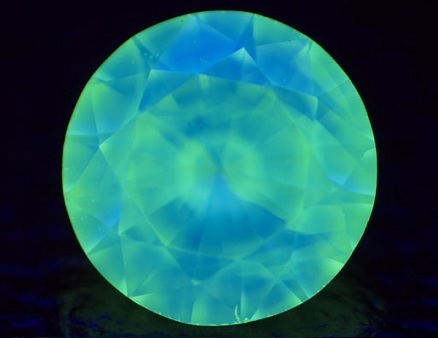Multi Colored Fluorescence Within a Diamond
Can Diamonds Fluoresce With A Mixture of Colors?
Well, the answer is yes and is dependent on the nature of the rough stone. Because diamonds form deep in the Earth, the material composition within a rough stone might differ and vary. However, the truth is that most naturally occurring diamonds do not exhibit such a phenomenon.


Synthetic diamond manufacturing process resulted in this cool looking stone.
In a nicely dispersed pattern, this diamond glows in both green and blue! Doesn’t it remind you of some weird planet in outer space seen with a telescope?
Interestingly, GIA does not describe fluorescence in multi-colors. Instead, only a single color description is used. In the case of this example, the predominant color is green. It would be reported as such and not a mixture of colors like bluish-green.
If you are specifically looking for such stones (whether they are natural or synthetic), I can tell you straight up that it would be impossible to purchase purely based on a grading report. You would either have to view the stone in person or get the vendor to analyse the diamond on your behalf.
Also, the point I want to bring across here is that even though mixed fluorescence looks cool, they are telltale signs of possible human manipulation in the manufacturing process. I want to stress again by saying that not all of such stones are artificial. If these stones are sold as natural diamonds, make sure you get an accompanying GIA report for the diamond.

Leave A Comment